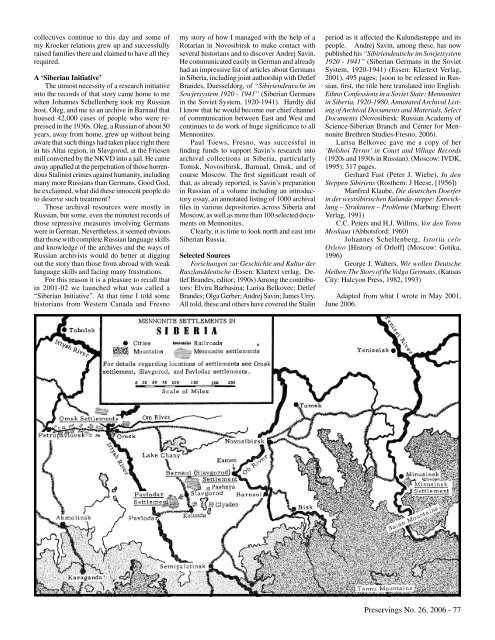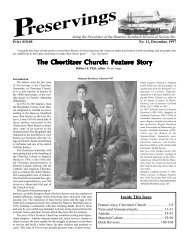Preservings $20 Issue No. 26, 2006 - Home at Plett Foundation
Preservings $20 Issue No. 26, 2006 - Home at Plett Foundation
Preservings $20 Issue No. 26, 2006 - Home at Plett Foundation
Create successful ePaper yourself
Turn your PDF publications into a flip-book with our unique Google optimized e-Paper software.
collectives continue to this day and some of<br />
my Kroeker rel<strong>at</strong>ions grew up and successfully<br />
raised families there and claimed to have all they<br />
required.<br />
A ‘Siberian Initi<strong>at</strong>ive’<br />
The utmost necessity of a research initi<strong>at</strong>ive<br />
into the records of th<strong>at</strong> story came home to me<br />
when Johannes Schellenberg took my Russian<br />
host, Oleg, and me to an archive in Barnaul th<strong>at</strong><br />
housed 42,000 cases of people who were repressed<br />
in the 1930s. Oleg, a Russian of about 50<br />
years, away from home, grew up without being<br />
aware th<strong>at</strong> such things had taken place right there<br />
in his Altai region, in Slavgorod, <strong>at</strong> the Friesen<br />
mill converted by the NKVD into a jail. He came<br />
away appalled <strong>at</strong> the perpetr<strong>at</strong>ion of those horrendous<br />
Stalinist crimes against humanity, including<br />
many more Russians than Germans. Good God,<br />
he exclaimed, wh<strong>at</strong> did these innocent people do<br />
to deserve such tre<strong>at</strong>ment?<br />
Those archival resources were mostly in<br />
Russian, but some, even the minutest records of<br />
those repressive measures involving Germans<br />
were in German. Nevertheless, it seemed obvious<br />
th<strong>at</strong> those with complete Russian language skills<br />
and knowledge of the archives and the ways of<br />
Russian archivists would do better <strong>at</strong> digging<br />
out the story than those from abroad with weak<br />
language skills and facing many frustr<strong>at</strong>ions.<br />
For this reason it is a pleasure to recall th<strong>at</strong><br />
in 2001-02 we launched wh<strong>at</strong> was called a<br />
“Siberian Initi<strong>at</strong>ive”. At th<strong>at</strong> time I told some<br />
historians from Western Canada and Fresno<br />
my story of how I managed with the help of a<br />
Rotarian in <strong>No</strong>vosibirsk to make contact with<br />
several historians and to discover Andrej Savin.<br />
He communic<strong>at</strong>ed easily in German and already<br />
had an impressive list of articles about Germans<br />
in Siberia, including joint authorship with Detlef<br />
Brandes, Duesseldorg, of “Sibiriendeutsche im<br />
Sowjetsystem 1920 - 1941” (Siberian Germans<br />
in the Soviet System, 1920-1941). Hardly did<br />
I know th<strong>at</strong> he would become our chief channel<br />
of communic<strong>at</strong>ion between East and West and<br />
continues to do work of huge significance to all<br />
Mennonites.<br />
Paul Toews, Fresno, was successful in<br />
finding funds to support Savin’s research into<br />
archival collections in Siberia, particularly<br />
Tomsk, <strong>No</strong>vosibirsk, Barnual, Omsk, and of<br />
course Moscow. The first significant result of<br />
th<strong>at</strong>, as already reported, is Savin’s prepar<strong>at</strong>ion<br />
in Russian of a volume including an introductory<br />
essay, an annot<strong>at</strong>ed listing of 1000 archival<br />
files in various depositories across Siberia and<br />
Moscow, as well as more than 100 selected documents<br />
on Mennonites.<br />
Clearly, it is time to look north and east into<br />
Siberian Russia.<br />
Selected Sources<br />
Forschungen zur Geschichte und Kultur der<br />
Ruszlanddeutsche (Essen: Klartext verlag, Detlef<br />
Brandes, editor; 1990s) Among the contributors:<br />
Elvira Barbasina; Larisa Belkovec; Detlef<br />
Brandes; Olga Gerber; Andrej Savin; James Urry.<br />
All told, these and others have covered the Stalin<br />
period as it affected the Kulundasteppe and its<br />
people. Andrej Savin, among these, has now<br />
published his “Sibiriendeutsche im Sowjetsystem<br />
1920 - 1941” (Siberian Germans in the Soviet<br />
System, 1920-1941) (Essen: Klartext Verlag,<br />
2001), 495 pages; [soon to be released in Russian,<br />
first, the title here transl<strong>at</strong>ed into English:<br />
Ethno Confessions in a Soviet St<strong>at</strong>e: Mennonites<br />
in Siberia, 1920-1980, Annot<strong>at</strong>ed Archival Listing<br />
of Archival Documents and M<strong>at</strong>erials, Select<br />
Documents (<strong>No</strong>vosibirsk: Russian Academy of<br />
Science-Siberian Branch and Center for Mennonite<br />
Brethren Studies-Fresno, <strong>2006</strong>).<br />
Larisa Belkovec gave me a copy of her<br />
‘Bolshoi Terror’ in Court and Village Records<br />
(1920s and 1930s in Russian). (Moscow: IVDK,<br />
1995), 317 pages.<br />
Gerhard Fast (Peter J. Wiebe), In den<br />
Steppen Sibiriens (Rosthern: J Heese, [1956])<br />
Manfred Klaube, Die deutschen Doerfer<br />
in der westsibirischen Kulunda-steppe: Entwicklung<br />
– Strukturen – Probleme (Marburg: Elwert<br />
Verlag, 1991)<br />
C.C. Peters and H.J. Willms, Vor den Toren<br />
Moskaus (Abbotsford: 1960)<br />
Johannes Schellenberg, Istoria celo<br />
Orlovo [History of Orloff] (Moscow: Gotika,<br />
1996)<br />
George J. Walters, Wir wollen Deutsche<br />
bleiben:The Story of the Volga Germans. (Kansas<br />
City: Halcyon Press, 1982, 1993)<br />
Adapted from wh<strong>at</strong> I wrote in May 2001,<br />
June <strong>2006</strong>.<br />
<strong>Preservings</strong> <strong>No</strong>. <strong>26</strong>, <strong>2006</strong> - 77
















